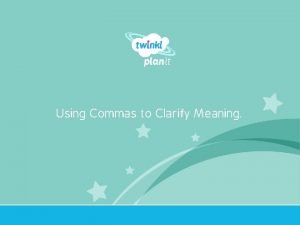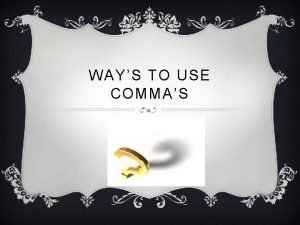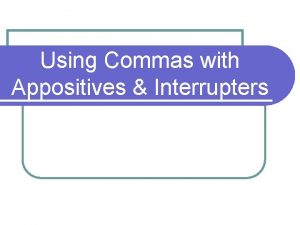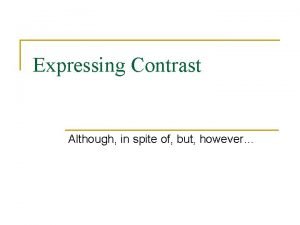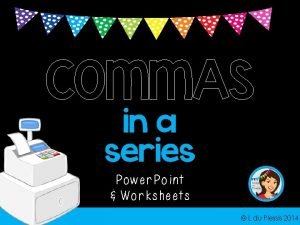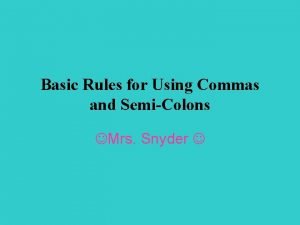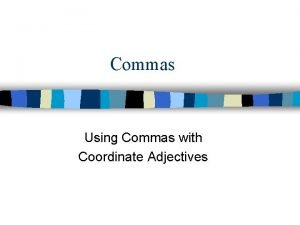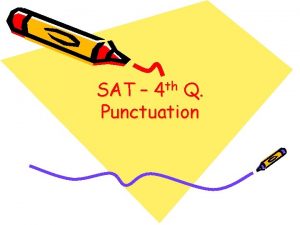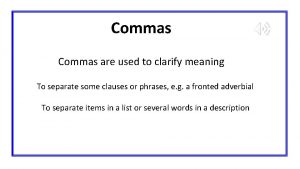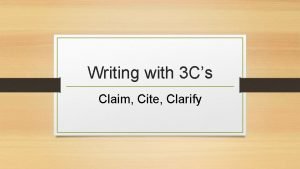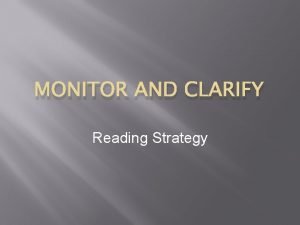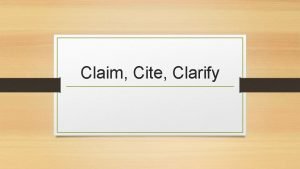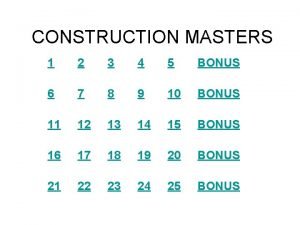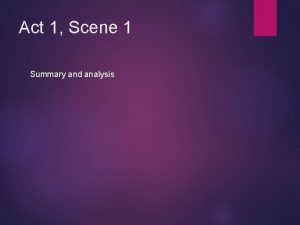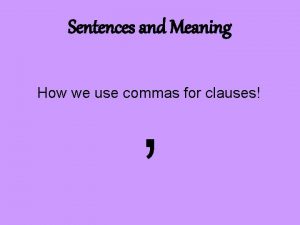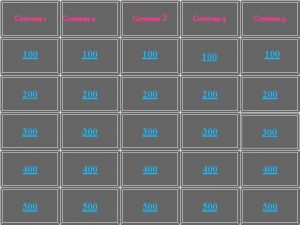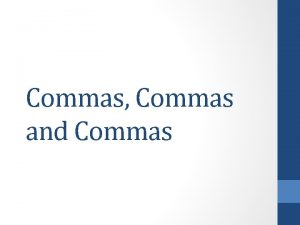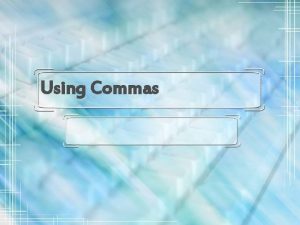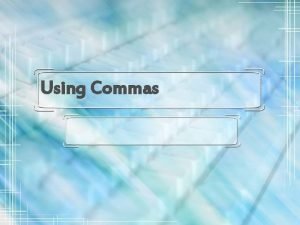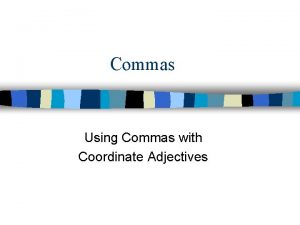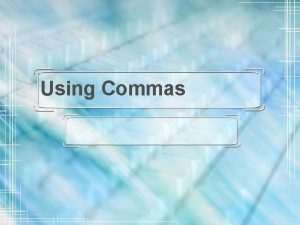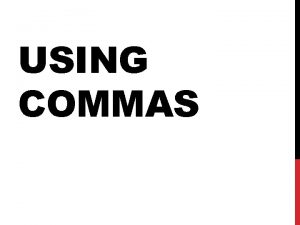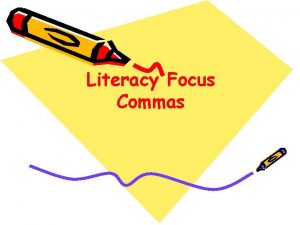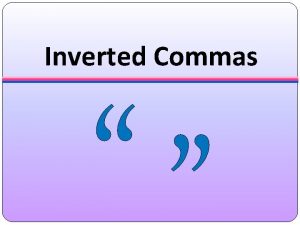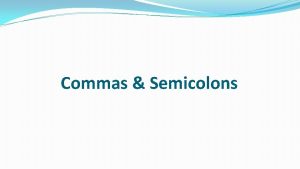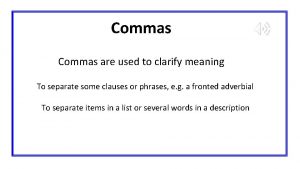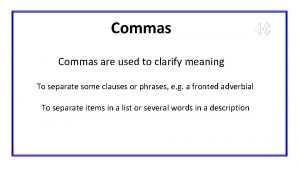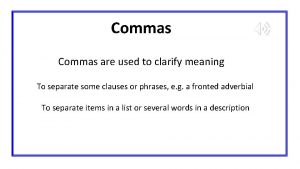Using Commas to Clarify Meaning Year One I



















- Slides: 19

Using Commas to Clarify Meaning. Year One



• I can use commas to make sure the reader understands precisely what I am trying to say. • I can tell when the meaning in a sentence is unclear. • I can suggest different meanings that a sentence could have. • I can add or remove commas to clarify the meaning of a sentence.


Can you give the reason that commas have been used in each of these example sentences? Discuss your thinking with a partner. Max had bought cheese, pears, sausage rolls and pickle, especially for the picnic. The commas are used to separate items in a list. Artem, who was only 9 years old, was a better piano player than many students twice his age. Artem, who are wasused only years old, was aclause better(anpiano many students hiswith age. The commas to 9 demarcate a relative addedplayer clause than of extra information thattwice begins a relative pronoun). The commas are needed because the relative clause is not essential to the meaning of the sentence. The rain was certainly heavy, but the Sun was suggesting it hadn’t gone for good. The comma separates two halves of a compound sentence. “I was amazed at how much I had got done in the day, ” she said. “IThis wascommas amazedisatused howtomuch I had in theis day, ” shebeing said in the sentence. indicate thegot enddone of what actually When they finally reached their destination, they realised he had been right all along! This comma is used to separate the main clause and subordinate clause. The artist, who was a bit of a dreamer, sat and painted the sea. The comma in this sentence demarcates the relative clause and makes the meaning clearer.

You may have already learned about using commas in these situations: To separate items in a list. After a fronted adverbial. To indicate extra information in a sentence. After direct speech. This lesson may call on your knowledge of general comma use but it is primarily about using commas to make the meaning of sentences absolutely clear. On some occasions a comma may be needed even though there is no grammatical rule that requires it.

Sometimes a comma can make a huge difference to the meaning of a sentence. Consider these two interpretations…


Draw the sentence Activity Sheet. Can you see how the meaning of some sentences can depend on punctuation? Use the drawings to interpret these sentences literally – draw exactly what they say.


Adding Commas Activity Sheet. Can you decide for yourself if a sentence is unclear or not? Read these sentences carefully and add commas if you think they are needed to make the meaning clearer.


Make Two Meanings Activity Sheet. Experience the power of punctuation by altering the meaning of these sentences armed only with commas!


Can you demonstrate your ability to use commas to make the meaning of sentences clearer and decide whether sentences can mean more than one thing or not. Work on your own to complete the Using Commas to Clarify Meaning Mini Test Activity Sheet.

Can you apply what you have learned about using commas to make the meaning clearer within a paragraph and are you able to dream up some sentences of your own which could mean more than one thing? Work on your own to complete the Application Activity Sheet.

• I can use commas to make sure the reader understands precisely what I am trying to say. • I can tell when the meaning in a sentence is unclear. • I can suggest different meanings a sentence could have. • I can add or remove commas to clarify the meaning of a sentence.

 Commas to clarify meaning
Commas to clarify meaning Using commas in dates
Using commas in dates Using commas in a list
Using commas in a list Interrupter and appositive
Interrupter and appositive However comma use
However comma use Commas in a series worksheet
Commas in a series worksheet Using however with commas
Using however with commas Commas adjectives
Commas adjectives Comma rules sat
Comma rules sat Using commas to separate clauses
Using commas to separate clauses Claim cite clarify
Claim cite clarify Monitor and clarify reading strategy
Monitor and clarify reading strategy The information needed to identify lines and other symbols
The information needed to identify lines and other symbols Claim cite clarify
Claim cite clarify To clarify any discrepancies in the plans use a
To clarify any discrepancies in the plans use a Visualize predict connect clarify
Visualize predict connect clarify Hunger games analysis essay
Hunger games analysis essay Mental models
Mental models Act 1 scene 1 hamlet
Act 1 scene 1 hamlet Midnight.commass
Midnight.commass
